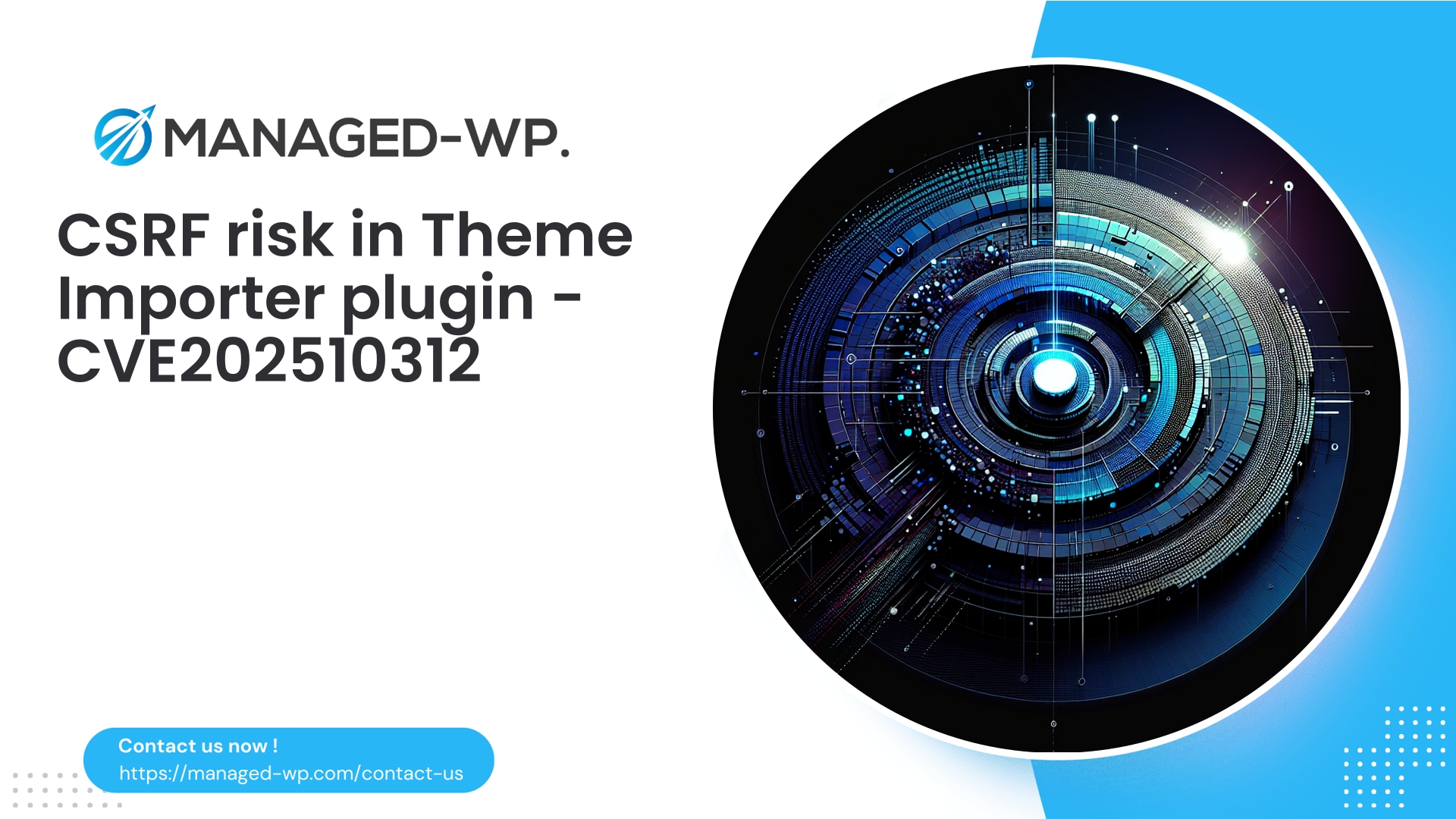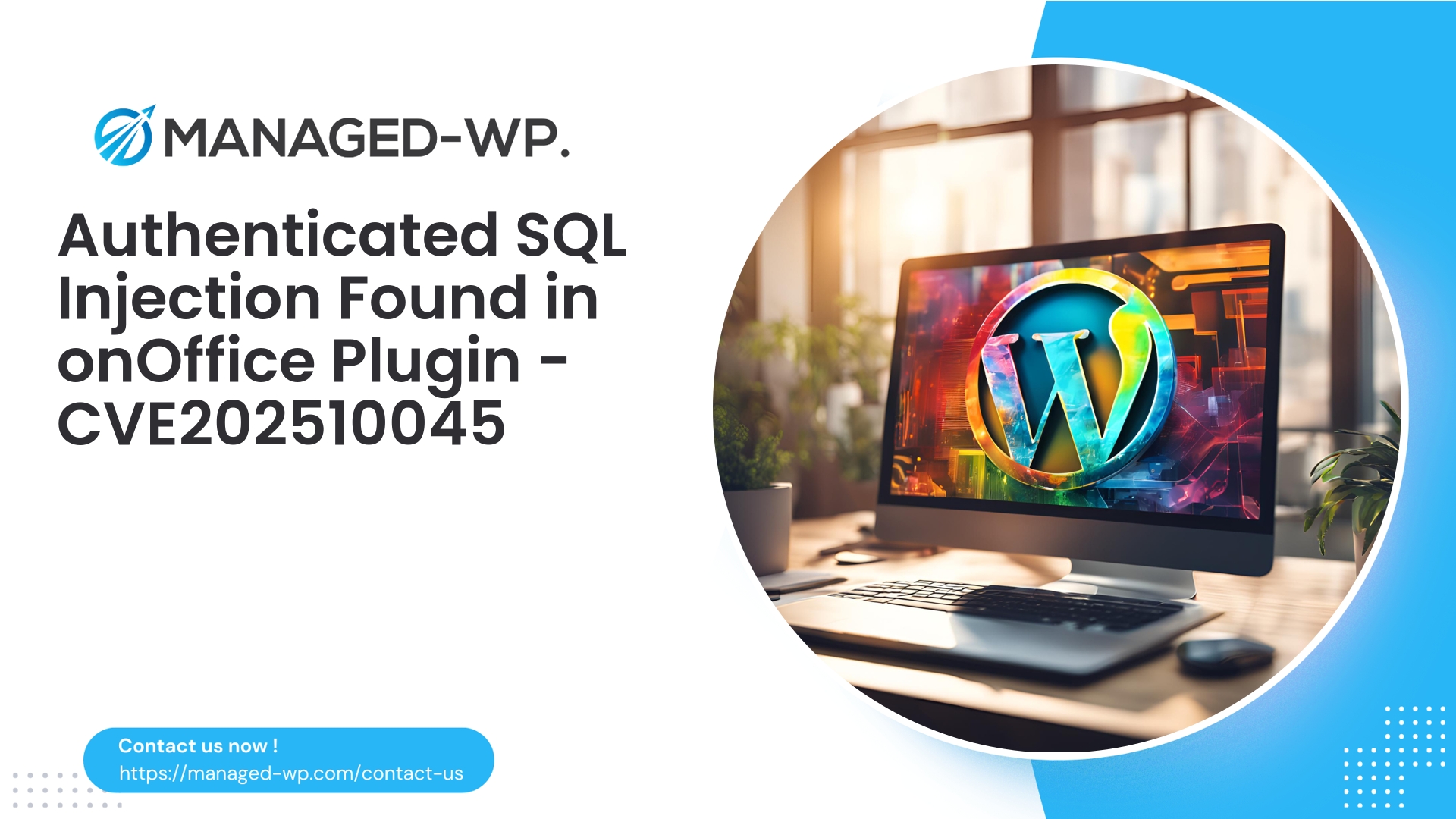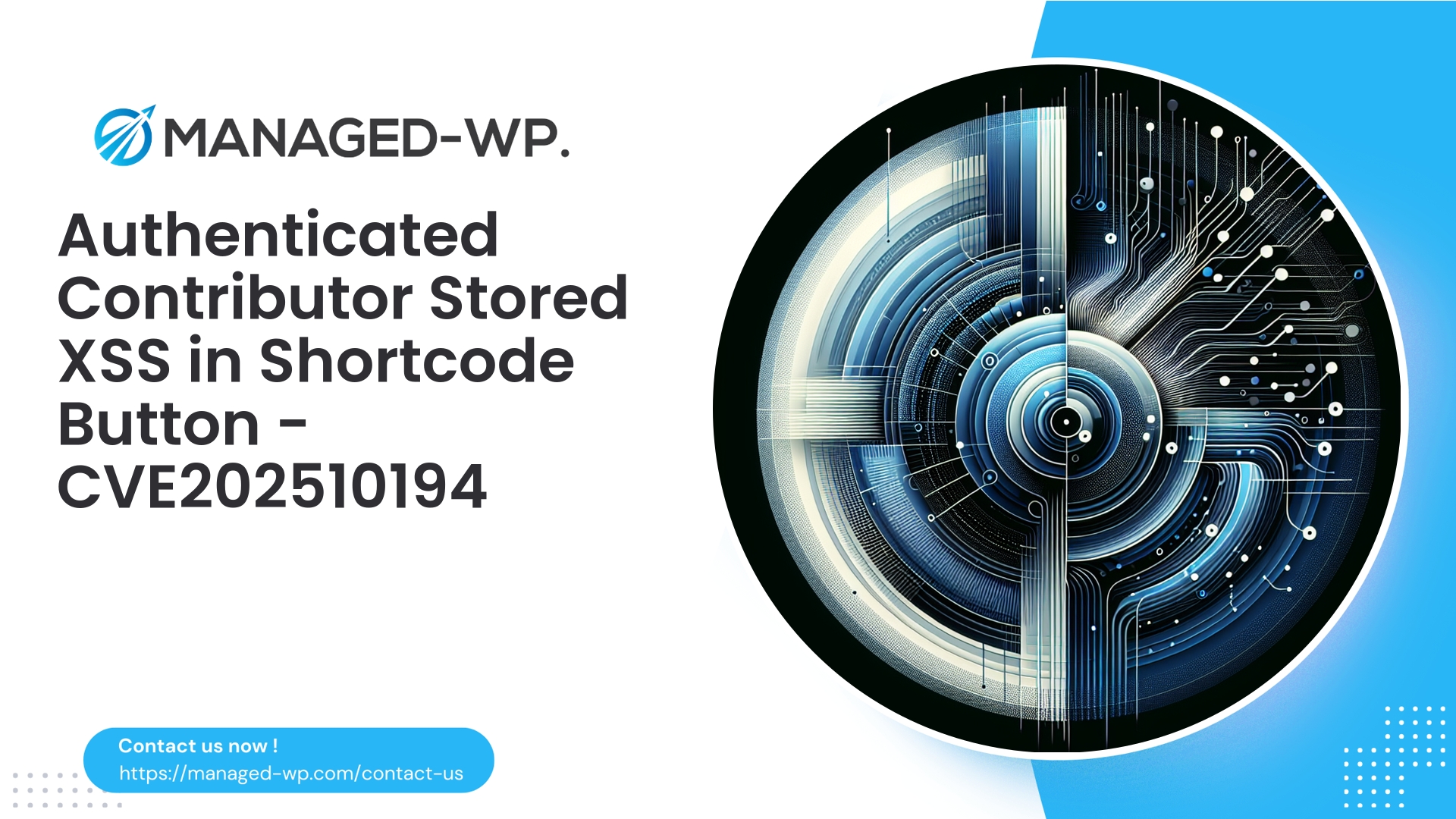| 插件名称 | 主题导入器 |
|---|---|
| 漏洞类型 | CSRF |
| CVE编号 | CVE-2025-10312 |
| 紧急 | 低的 |
| CVE 发布日期 | 2025-10-15 |
| 源网址 | CVE-2025-10312 |
主题导入器(≤ 1.0)CSRF 漏洞(CVE-2025-10312)—— WordPress 网站所有者的重要信息
作者: 托管式 WordPress 安全专家
日期: 2025-10-16
执行摘要
最近披露的一个跨站请求伪造 (CSRF) 漏洞影响 WordPress 主题导入器插件 1.0 及更早版本 (CVE-2025-10312)。虽然该漏洞的严重性评级较低,但由于官方尚未发布补丁,WordPress 网站管理员仍需保持警惕。CSRF 漏洞,即使是 CVSS 评分中等的漏洞,也可能被利用,成为针对网站安全的更复杂攻击链的一部分。本文将详细介绍该漏洞,评估其实际风险,概述攻击者的攻击方法,并提供切实可行的缓解策略,以保护您的 WordPress 环境,直到官方发布补丁为止。
笔记: 我们的分析专为网站所有者、管理员和 WordPress 专业人士量身定制。为秉持负责任的信息披露原则,我们省略了敏感的漏洞利用数据。
内容
- 背景和披露详情
- 了解 CSRF 及其对 WordPress 的影响
- 主题导入器 CSRF 漏洞详情
- 攻击场景与现实风险
- 立即采取的缓解措施
- 长期补救措施和最佳实践
- 检测技术和入侵指标 (IoC)
- Managed-WP 如何保护您的网站安全(虚拟修补和监控)
- 事件后响应和恢复
- 常见问题解答 (FAQ)
- 使用 Managed-WP 免费计划获取基本保护
背景和披露详情
2025年10月15日,CVE-2025-10312发布,描述了WordPress主题导入器插件1.0及以下版本中的一个CSRF漏洞。该漏洞由一位安全研究人员负责任地报告,并根据CVSS 4.3被评为低危漏洞。值得注意的是,截至本次披露时,插件供应商尚未发布官方补丁。
事实概述:
- 受影响的软件: 主题导入器 WordPress 插件
- 易受攻击的版本: 版本≤1.0
- 漏洞类型: 跨站请求伪造 (CSRF)
- CVE标识符: CVE-2025-10312
- 报告日期: 2025年10月15日
- 当前修复状态: 没有可用的厂商补丁
- 报道人: 安全研究员(署名)
鉴于官方尚未发布更新,Managed-WP 建议所有网站管理员和主机商立即实施补偿控制措施和虚拟补丁。
了解 CSRF 及其对 WordPress 的重要性
跨站请求伪造 (CSRF) 是一种网络安全漏洞,攻击者利用用户当前的登录会话,通过精心构造的请求,在用户不知情的情况下执行未经授权的 Web 操作。在 WordPress 环境中,成功的 CSRF 攻击可以更改插件或主题设置、创建或修改内容、添加管理员帐户,或在未经用户同意的情况下触发其他管理操作。
CSRF 的工作原理:
- 受害者与目标 WordPress 网站保持着活跃会话。
- 攻击者诱骗受害者访问恶意网站或点击精心构造的链接。
- 恶意页面或电子邮件会触发对 WordPress 网站的未经授权的 HTTP 请求。
- 用户的浏览器包含会话 cookie,如果没有采取保护措施,则可能导致破坏性操作。
WordPress 防御 CSRF 的措施:
- WordPress 集成了 nonce(一次性使用的数字)和权限检查来验证管理操作。
- 编写得当的插件和主题会利用
检查管理员引用者(),wp_verify_nonce()或同等保障措施。 - 缺少或存在缺陷的 nonce 验证可能导致恶意跨域请求执行敏感更改。
笔记: 并非所有 CSRF 漏洞都需要经过身份验证的用户;某些端点可能会处理未经身份验证的请求,或者缺乏严格的访问控制。漏洞利用的可能性很大程度上取决于插件的设计和端点的暴露程度。
主题导入器 CSRF 漏洞的技术细节
该安全公告指出,主题导入器版本≤1.0由于缺少随机数验证和功能检查不足,导致端点存在跨站请求伪造(CSRF)漏洞。较低的CVSS评分表明其短期影响有限,但这并不意味着可以忽略该漏洞的风险。
- 易受攻击的端点接受状态更改请求(例如,主题导入触发器)。
- 由于缺少 nonce 验证,可以伪造请求并冒用已认证用户的身份发出请求。
- 该漏洞可能被诱骗技术利用,胁迫管理员用户执行非预期操作。
重要考虑因素:
- 低危性评级并不意味着不需要采取行动;漏洞可能会连锁或放大。
- 由于没有官方补丁可用,因此通过禁用插件或应用防火墙规则来降低风险至关重要。
真实的攻击场景及后果
评估实际威胁形势有助于确定防御和应对计划的优先顺序。
潜在攻击者的目标包括:
- 强制进行管理更改,例如导入恶意配置数据。
- 操纵已认证用户执行有害操作。
- 将 CSRF 与其他漏洞(例如不安全的文件上传)结合起来,以部署后门。
- 注入恶意脚本以危害网站访问者。
可能的攻击方式:
- 管理员目标: 攻击者诱使当前已登录的管理员访问恶意内容,从而触发存在漏洞的插件的操作。
- 漏洞利用链: 利用 CSRF 作为更广泛的攻击框架中的跳板,以获得持久访问权限或提升权限。
- 自动化大规模剥削: 攻击者扫描多个网站,寻找存在漏洞的插件,以伺机最大化攻击效果。
影响概要:
- 直接影响包括未经授权的配置更改和插件状态变更,通常可以通过备份恢复。
- 间接影响是与其他脆弱性因素相结合造成的,会大大加剧其严重性。
在官方修复程序发布之前,Managed-WP 强调应采取积极主动的缓解措施来应对此漏洞。
您应立即采取的缓解措施
使用 Theme Importer 插件 1.0 或更早版本的 WordPress 网站所有者应优先执行以下操作:
- 审核您的网站: 确认哪些安装包中存在存在漏洞的插件。
- 禁用或移除插件: 如果主题导入器并非必需,请将其卸载以避免风险。
- 访问控制: 通过 IP 限制或 HTTP 身份验证来限制 wp-admin 访问权限,以加强管理员会话的安全性。
- 会话强化: 实施双因素身份验证并配置 SameSite cookie 属性(严格或宽松)以防止 CSRF。
- 部署防火墙保护: 建立 WAF 规则或虚拟补丁,以阻止对插件端点的未经验证的请求,直到打上补丁为止。
- 监控网站活动日志: 查看管理员日志中是否存在可疑的 POST 请求和未经授权的更改。
- 限制管理员角色: 审核管理员用户,删除未使用的帐户,并强制执行强密码策略。
- 备份: 准备干净的站点快照和数据库,以便在发生安全漏洞时能够快速恢复。
理由: 禁用插件最为简单。如果插件必须保持启用状态,则结合访问限制和虚拟补丁可以降低漏洞利用风险。
长期补救和安全发展指南
Theme Importer 或相关插件的开发者和维护者应遵守已建立的 WordPress 安全最佳实践:
- 实施 nonce 保护: 使用
wp_create_nonce()并用……进行验证检查管理员引用者()或者wp_verify_nonce()任何修改状态的请求。 - 验证用户能力: 采用
当前用户可以()严格检查。 - 杜绝对敏感端点的未经身份验证的访问: 防止匿名用户触发状态更改。
- 对所有输入数据进行清理和验证: 请正确使用WordPress的清理功能。
- 保护 AJAX 和 REST 端点: 需要 nonce 检查或等效的授权处理程序。
- 安全的文件导入处理: 限制允许的文件类型,清理文件名,并安全地存储文件。
- 遵循最小特权原则: 最大限度地减少授予行动的能力。
- 保持依赖项更新: 定期维护第三方代码。
- 记录操作并限制可疑活动: 整合监控和限速功能,以便及早发现异常情况。
发现漏洞后及时与用户进行透明沟通,并及时发布补丁,对于建立信任和安全至关重要。
检测入侵尝试和入侵指标 (IoC)
鉴于 CSRF 的特性,其迹象可能很微妙,但请注意以下几点:
- 针对主题导入器端点的意外 POST 请求。
- 审计日志中出现无法解释的管理变更或新用户。
- 主题或插件文件被可疑地修改过。
- Referer 标头格式错误或缺失,且与状态变更同时发生。
- 对计划任务或定时任务进行更改。
监测区域包括:
- Web 服务器访问日志过滤,查找插件 URI 模式。
- WordPress 审核或活动日志过滤插件相关的更改。
- 安全日志突出显示了失败或缺失的 nonce 验证尝试。
如果发现可疑活动:
- 将站点置于维护模式并立即隔离。
- 保留完整的日志和服务器快照,以备取证审查。
- 轮换并加强所有管理员帐户的凭据。
- 必要时从已验证的干净备份中恢复。
Managed-WP 如何保护您的 WordPress 安装
Managed-WP 的分层安全解决方案有助于在补丁程序发布期间保护您的网站免受攻击:
- 虚拟修补: 我们在 HTTP 请求层部署规则,以阻止针对易受攻击的插件端点的恶意流量,而无需修改源代码。
- 请求过滤: 阻止未经授权或格式错误的请求,这些请求缺少有效的 nonce 令牌或可疑的 Referer 标头。
- 运行时保护与速率限制: 检测并阻止自动扫描或重复利用攻击的尝试。
- 警报与报告: 发送包含 IP 地址、用户代理、来源网址和有效负载片段等上下文信息的详细警报,供管理员审核。
- 无缝补丁过渡: 虚拟补丁将一直保留,直到供应商的更新能够安全部署和测试为止。
- 爆炸半径减小: Managed-WP 的集中管理最大限度地降低了跨多个站点或客户环境的风险。
对于因兼容性或操作方面的考虑而无法立即更新插件的网站来说,虚拟修补至关重要。
WAF 规则概念示例
为了让管理员了解保护逻辑,针对此问题的 WAF 可能包含以下内容:
- 在以下情况下阻止向主题导入器端点发送 POST 请求:
- Referer 标头缺失或为外部标头,且
- 有效的 WordPress nonce 缺失或无效,或者
- 检测到与主题导入器相关的意外操作参数。
- 拒绝以下请求:
- 包括来自非管理员 IP 地址范围的可疑操作名称。
- 尝试在未进行正确的 nonce 验证的情况下调用 admin-ajax.php。
- 对来自单个 IP 地址的频繁导入端点请求进行限流和速率限制。
- 暂时屏蔽产生多次 nonce 验证失败的 IP 地址。
此类规则既能保持合法的管理功能,又能大幅限制攻击途径。
事件后响应和恢复指南
如怀疑存在数据剥削行为,请执行以下程序:
- 隔离并保存证据: 启用维护模式并保护日志、数据库转储和文件系统副本。
- 撤销凭证: 重置所有管理员帐户凭据并撤销 API 和应用程序密码。
- 恶意软件和后门扫描: 使用多种扫描工具并手动检查上传文件、插件和主题目录是否存在异常。
- 恢复干净备份: 优先使用事件发生前的备份,确保恢复前备份的完整性。
- 加强安保: 重新应用缓解措施,包括移除插件、激活 WAF、控制 cookie 和启用双因素身份验证。
- 应用供应商补丁: 如有官方插件更新,请在正式发布前,先在测试环境中进行测试和安装。
- 保持监控: 恢复后,继续密切审查日志并进行审计跟踪。
- 聘请专业人士: 对于重大或复杂的事件,请考虑寻求专业的事件响应援助。
常见问题解答 (FAQ)
问: CVSS评分较低;我还需要采取行动吗?
一个: 没错。即使是低风险漏洞,也可能与其他漏洞连锁反应,造成重大安全隐患。主动缓解措施可以降低整体风险。
问: 移除插件是我唯一的选择吗?
一个: 移除是最彻底的解决方案。如果移除不可行,请使用防火墙规则限制管理员会话的暴露,直到发布补丁为止。
问: 虚拟补丁会影响插件功能吗?
一个: 适当定制的虚拟补丁可以防止漏洞利用,同时又不妨碍合法的管理行为。
问: 缓解措施应该持续多久?
一个: 在厂商发布官方补丁之前,请继续采取保护措施,并在之后继续监控。
问: 我是否应该举报任何可疑事件?
一个: 是的。向您的主机提供商以及(在适当情况下)插件开发者报告事件,可以帮助协调更广泛的事件响应和修复工作。
使用 Managed-WP 免费计划,立即获得基础保护
使用 Managed-WP Basic(免费)快速启动您的防御系统
为了在规划更新时快速保护您的 WordPress 网站,请考虑使用 Managed-WP Basic(免费)套餐,该套餐提供:
- 综合管理型防火墙和Web应用程序防火墙(WAF)
- 无限带宽,并提供 HTTP 层保护
- 恶意软件扫描以检测威胁
- 针对 OWASP 十大风险的预置防御措施
立即注册,即可获得针对新兴威胁的基本安全防护: https://my.wp-firewall.com/buy/wp-firewall-free-plan/
需要高级修复功能?付费方案包括自动恶意软件清理、IP 访问控制、漏洞虚拟修补、报告功能,以及面向机构和多站点管理人员的企业级功能。
最终建议——纵深防御是你的最佳策略
这个主题导入器 CSRF 漏洞凸显了 WordPress 网站插件安全防护的重要性。即使是低危漏洞也应引起高度重视,因为它们可能被多阶段攻击利用。
- 禁用和移除未使用的插件,以最大限度地减少攻击面。
- 通过双因素身份验证、会话策略和 IP 限制来加强会话安全性。
- 利用防火墙和虚拟补丁立即降低风险。
- 持续监控日志和网站活动。
- 及时应用厂商补丁,并保持所有插件和主题更新。
Managed-WP 提供及时的保护规则,以降低漏洞披露到修补期间的风险。对于管理多个站点的组织而言,结合备份、虚拟修补和监控的协调策略能够提供最佳的防御。
如需评估 WordPress 项目组合中的漏洞风险,Managed-WP 的安全专家随时为您提供帮助。您可以先使用我们的免费方案,立即获得基础防护: https://my.wp-firewall.com/buy/wp-firewall-free-plan/
保持警惕,并持续投资于网站安全——当出现新的威胁时,这将带来丰厚的回报。
— Managed-WP 安全团队



















